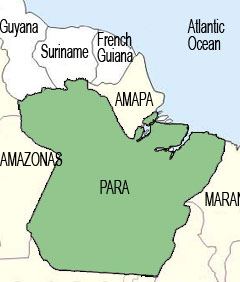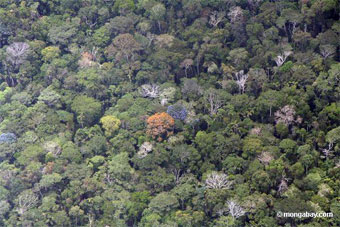Brazil creates world’s largest rainforest reserve
Brazil creates world’s largest rainforest reserve
mongabay.com
December 4, 2006
Brazil created the world’s largest expanse of protected tropical rainforest in Pará, the state where American nun Dorothy Stang was murdered after trying to protect land rights of rural poor. The network of seven new protected areas covers an expanse of 15 million hectares (57,915 square miles) — or an area larger than England — and links to existing reserves to form a vast conservation corridor in the northern Amazon, one of the most biodiverse regions on the planet.
The effort was backed by Pará State Government, the Amazon Institute of People and the Environment (IMAZON), Conservation International (CI), the Gordon and Betty Moore Foundation, and WWF.

|
“The new protected areas complete the Brazilian portion of the Guayana Shield corridor of Amazon rainforest stretching from neighboring Guyana, Suriname and French Guiana into Brazil,” read a statement from CI. “The Guayana Shield region is a global conservation priority, containing more than 25 percent of Earth’s humid tropical forests. Almost 90 percent of the Guayana Shield forest is untouched, and the region contains the most significant freshwater reserves in the American tropics, with almost 20 percent of the world’s water running through it.”
“These new protected areas will also form the world’s largest conservation corridor, connecting them to a big protected area in Amapá, which includes the Montanhas do Tumucumaque National Park, which until now was the biggest protected area created in the Brazilian Amazon. This mosaic of protected areas will be further connected, through indigenous people’s lands, with other protected areas in the Brazilian states of Roraima and Amazonas,” added a media release from WWF.
Conservation is working, but better in Brazil than neighboring countries
 Photos by Rhett A. Butler. |
While nearly 90 percent of the Guayana Shield rainforest in unscathed, in recent years the region has come under increasing development pressure from illegal logging and informal gold mining. Park and forest encroachment has been widespread in Guyana, Venezuela, Suriname, and French Guiana, where the governments have had little success in reigning in illegal activities. In the Brazilian part of Guayana Shield, environmental law enforcement has improved dramatically in recent years.
Since 2002 the Brazilian government has moved to reign in forest clearing by setting aside more than 100 million hectares of the Amazon basin from development and cracking down on illicit activities. These efforts, combined with lower commodity prices may be paying off: forest loss for the 2005-2006 year was down more than 40 percent from the prior year. The 2005-2006 figure — 13,100 square kilometers (5,057 square miles) — is the lowest since 1991 when 11,130 square kilometers (4,258 square miles) of forest were lost.
Nevertheless, since the early 1970s about 650,00 square kilometers (250,000 square miles) or 18 percent of the Amazon rainforest — have been destroyed, mostly for cattle pasture and agriculture. Scientists say that continued forest loss could turn much of the Amazon rainforest into savanna, putting the region’s biodiversity at risk — the Amazon may be home to as much as one-third of the planet’s terrestrial species.
The new parks are an important step in slowing deforestation. Studies have shown that protected areas — especially those inhabited by indigenous populations — have considerably lower rates of fire and forest loss than unprotected areas.
Environmentalists are happy — almost
Environmentalists heralded the creation of the new protected areas:
-
“The creation of these new protected areas is of enormous relevance for conservation of the Amazon,” said Denise Hamú, CEO of WWF-Brazil.
“This is the greatest effort in history toward the creation of protected areas in tropical forests,” added Adalberto Veríssimo, senior researcher at IMAZON.
“If any tropical rainforest on Earth remains intact a century from now, it will be this portion of northern Amazonia, due in large part to the governor’s visionary achievement,” CI President Russell A. Mittermeier said.
… while warning that further steps are needed to ensure the conservation project is a success:
-
“Just creating protected areas isn’t enough,” said Claudio Maretti of the World Wildlife Fund, which supported the new parks in Para. “You have to develop an economy for the forest.”
Related articles
Amazon natives use Google Earth, GPS to protect rainforest home. Deep in the most remote jungles of South America, Amazon Indians (Amerindians) are using Google Earth, Global Positioning System (GPS) mapping, and other technologies to protect their fast-dwindling home. Tribes in Suriname, Brazil, and Colombia are combining their traditional knowledge of the rainforest with Western technology to conserve forests and maintain ties to their history and cultural traditions, which include profound knowledge of the forest ecosystem and medicinal plants. Helping them is the Amazon Conservation Team (ACT), a nonprofit organization working with indigenous people to conserve biodiversity, health, and culture in South American rainforests.
Brazil establishes 3 new parks in the Amazon rainforest. Last month Brazilian President Luiz Inacio Lula da Silva decreed three new protected areas in the Amazon basin, placing 1.84 million hectares (4.55 million acres) of rainforest off-limits for development. The environmental ministry said that since 2002 President Silva has created 57 protected areas in the Amazon preserving some 19.3 million hectare of rainforest. More than twice that area — at least 55 million hectares — has been cleared since 1978, mostly as a result of forest conversion for cattle pasture and settlement.
more Amazon rainforest news